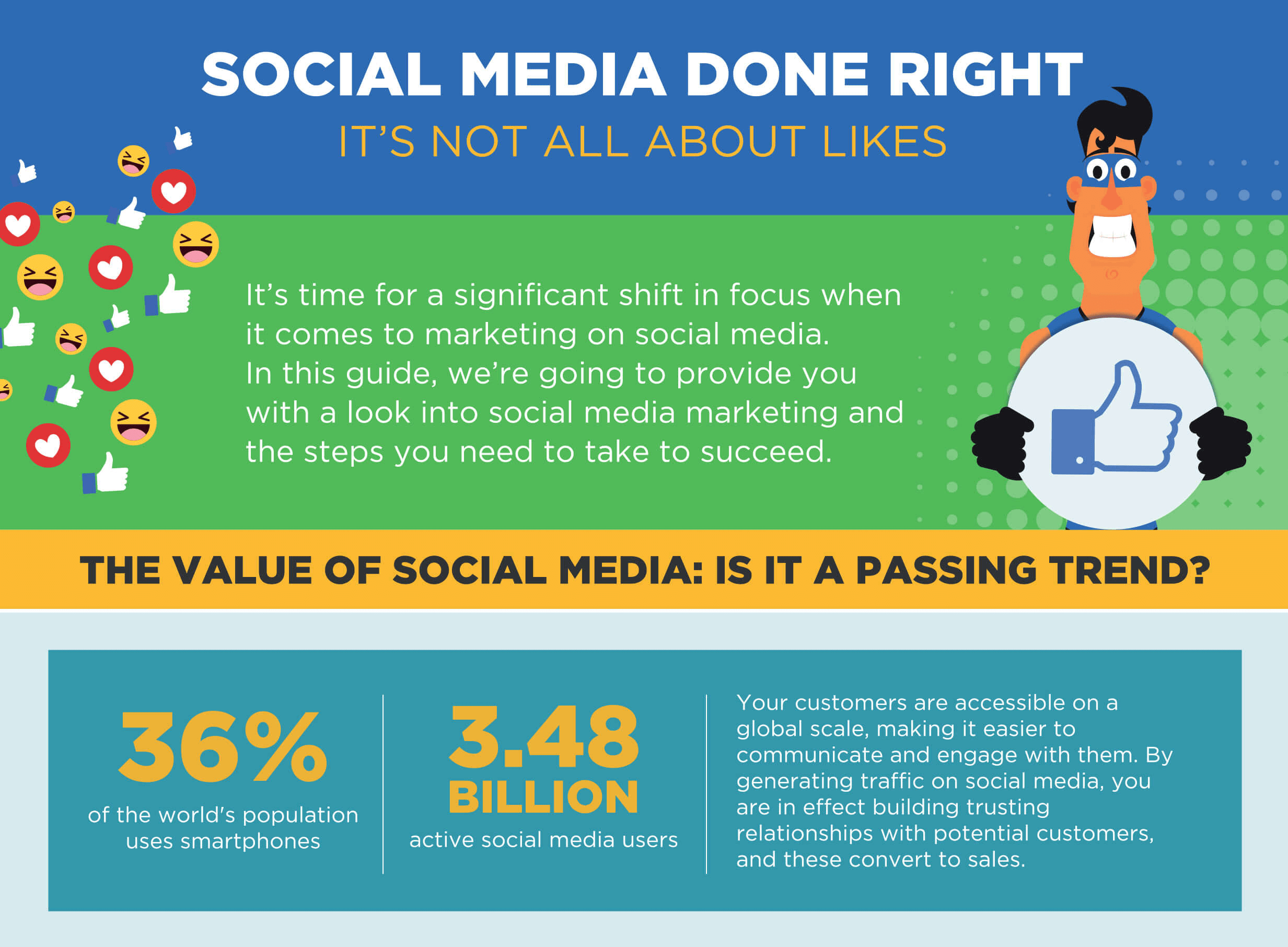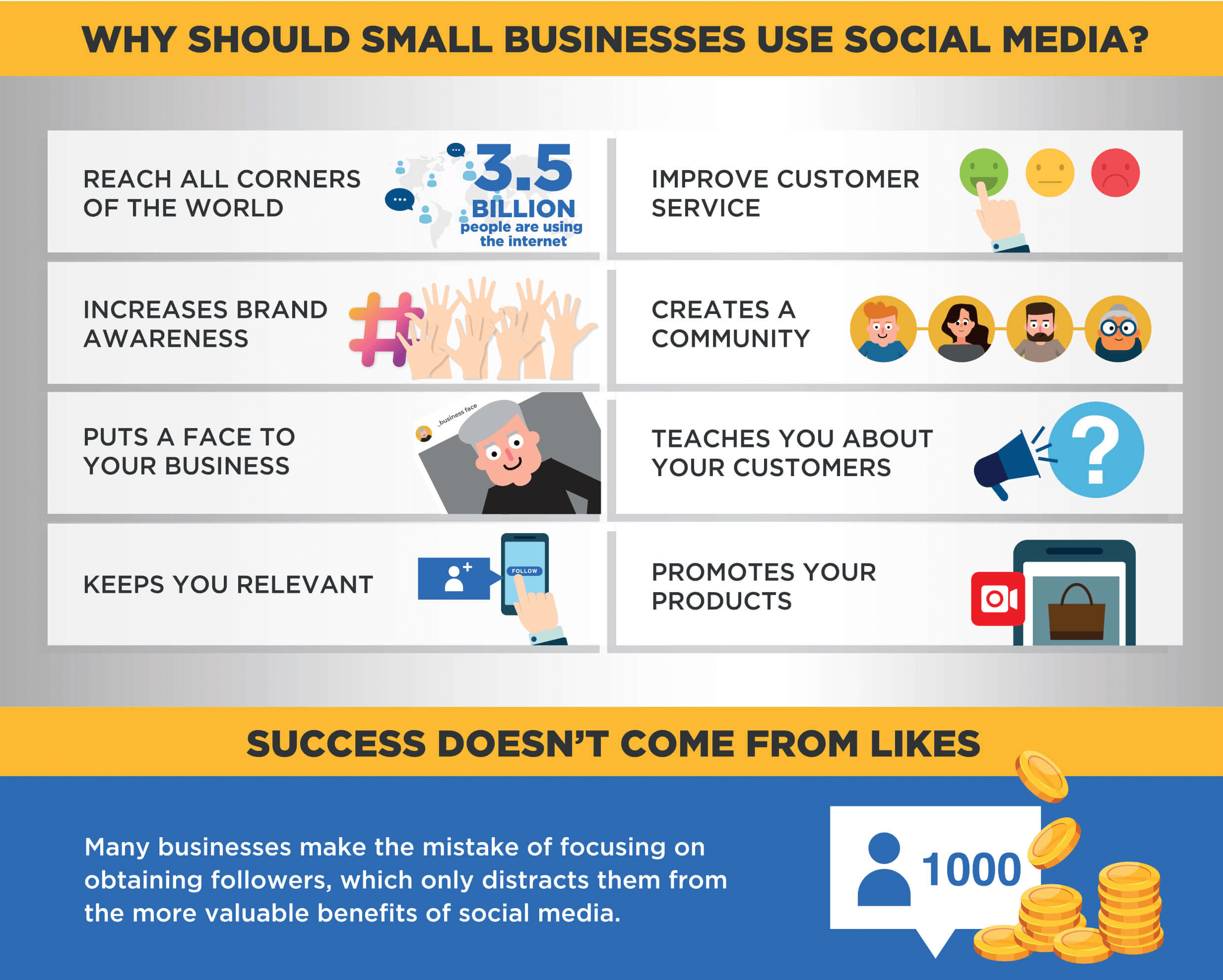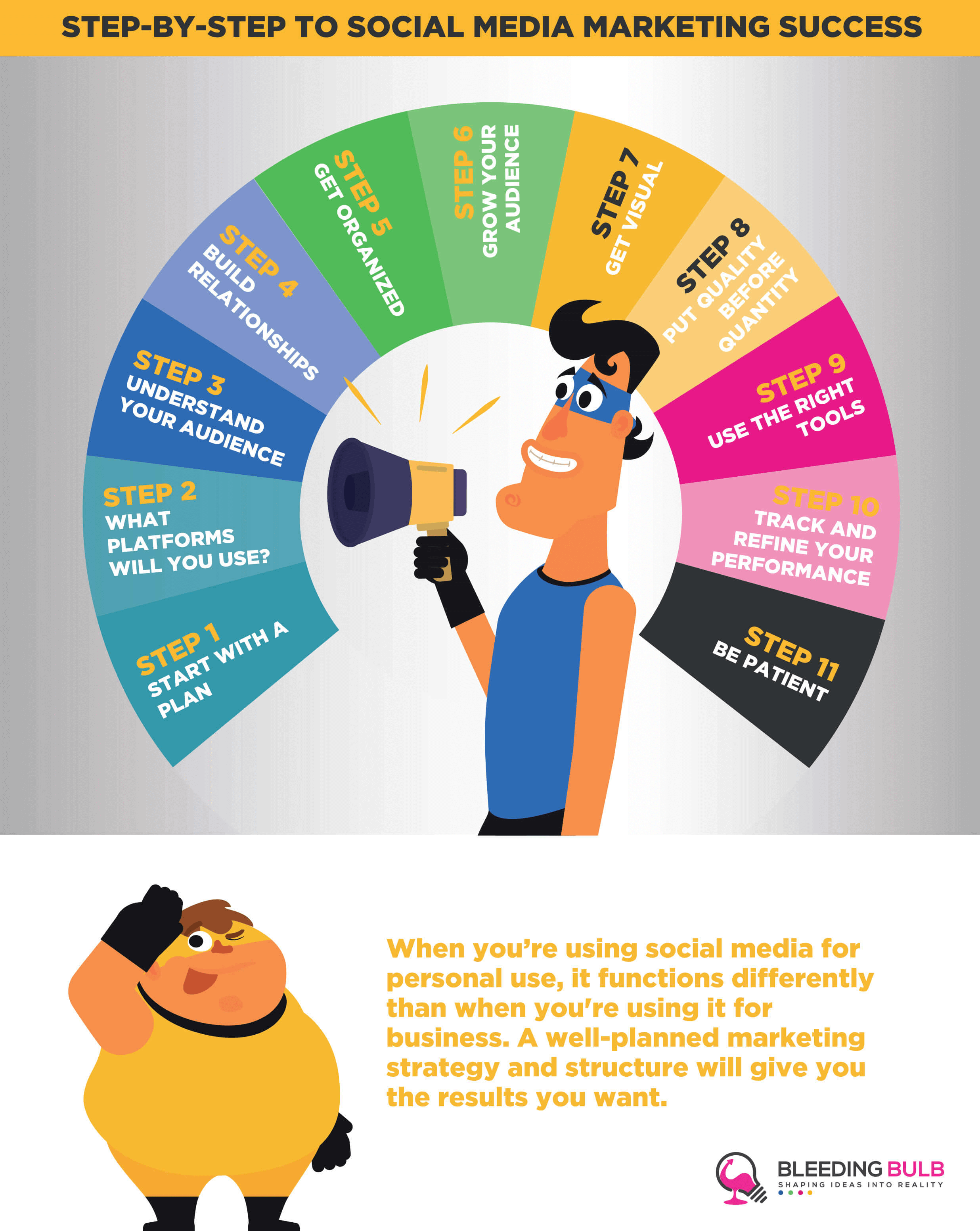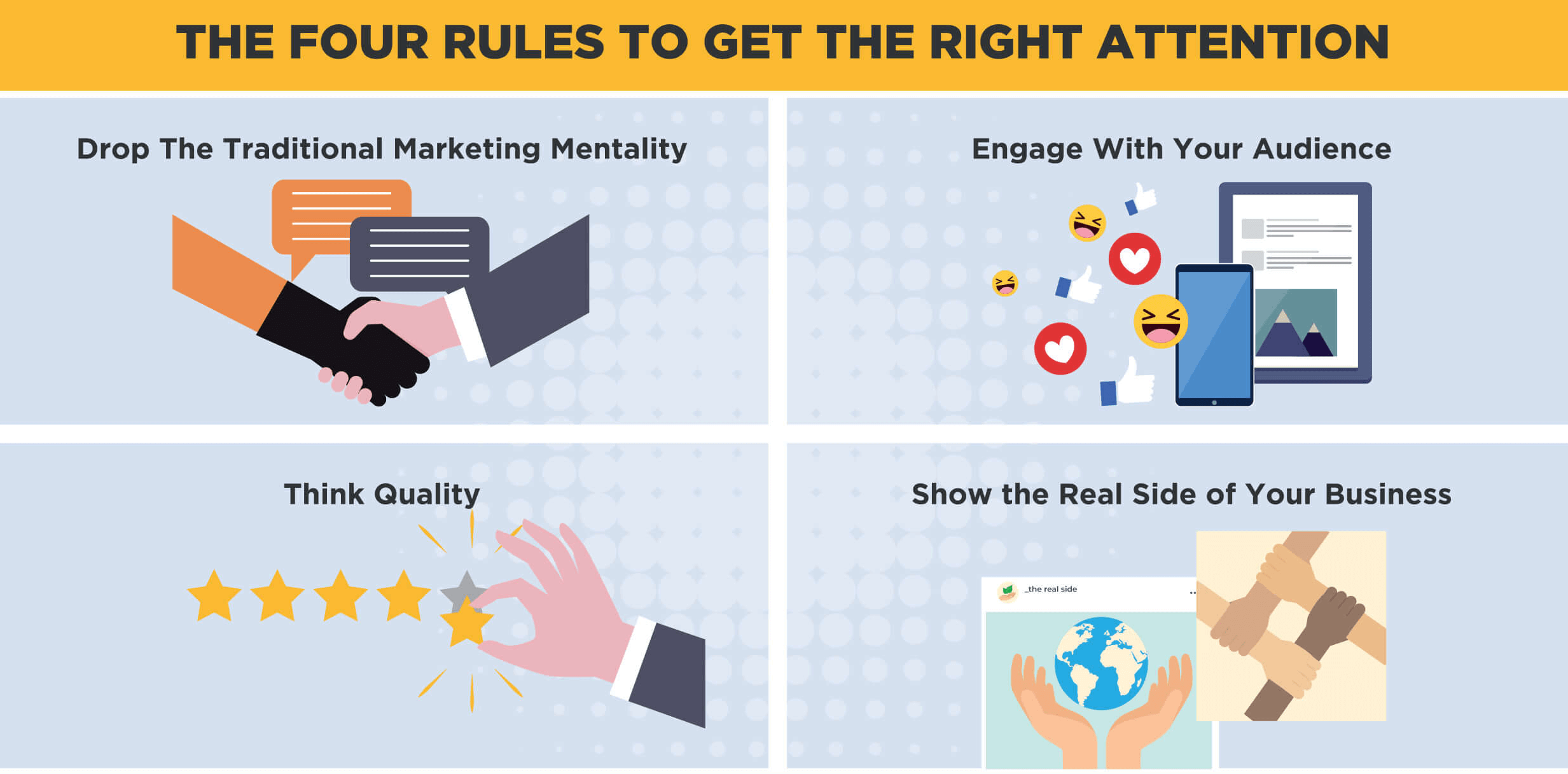The Value of Social Media: Is It a Passing Trend?
Why Should Small Businesses Use Social Media?
Success doesn’t come from likes
The Four Rules to Get the Attention
Step-by-Step to Social Media Marketing Success
Introduction
Whether you like it or not, social media has become one of the most powerful tools in marketing for large and small businesses alike. Once nobodies, thousands of small companies have transformed themselves into influential brands through the use of apps such as Facebook, Instagram, and SnapChat. Businesses both big and small are jumping on the social media bandwagon and using it to their advantage. Not only are companies quickly able to reach potential customers all over the world, but they can also gain followers through this cost-effective platform.
So if social media is the place to be for businesses, then why are there still businesses struggling to reap the benefits of these social platforms? The probable reason is that they’re not focusing on the right things. If social media is done right - it’s not all about likes. Unfortunately this is what many businesses have yet to understand. Just because a company has followers on social media, doesn’t mean they’re getting sales.
It’s time for a significant shift in focus when it comes to marketing on social media. Because at the end of the day, whether you’re an online business or not, if you want the sales you’re going to have to work for it. In this guide, we’re going to provide you with a look into social media marketing and the steps you need to take to succeed.

The Value of Social Media: Is It a Passing Trend?
Let’s get this question out of the way first. Many businesses are hesitant to join social media, thinking it’s just a passing trend. In reality, social media isn’t going anywhere; instead, it’s growing exponentially. As the world’s population increasingly gains access to the internet, people are more connected than ever, and more connected with companies through social media.
With over 36 percent of the world’s population using smartphones and 3.48 billion active social media users, having a social media account is like holding a golden goose. Your customers are accessible on a global scale, making it easier to communicate and engage with them. But does this translate to sales? In short, yes. By generating traffic on social media, you are in effect building trusting relationships with potential customers, and these convert to sales.
If social media isn’t going anywhere, there’s only one thing you can do: join the bandwagon. Even though many businesses are turning to social media, there are still businesses unknown to the online world. As a business owner, you may not be completely sold on the idea of having an online presence, but you’re missing out on huge opportunities for growth. We’re going to tell you the reasons why you should join the world of social media.
Why Should Small Businesses Use Social Media?
Social media has become less of choice and more of a requirement. The fact of the matter is that people are living online. When they’re on the bus on the way home from work, they’re online. When they’re waiting at the doctor’s office, they’re online. People aren’t walking around the mall or shopping centers that much anymore; they’re going online to find the latest deals. Every day your business isn’t online, you are missing out on potential customers all around the world.

Naturally, there are many businesses that are comfortable not using social media. Perhaps their services are meant for local use or they feel that they have enough business as it is. However social media isn’t used only for boosting sales. There are many more advantages to having a social media presence other than boosting sales. Here are some benefits of businesses being active on social media.
Reach All Corners of the World
3.5 billion people are using the internet. This means 45% of the world’s population has access to your website and/or social media page. Now, that’s a lot of people. This doesn’t mean 3.5 billion people are going to be buying from you. But it does create an excellent opportunity for you to expand your clientele and enter into the global market. The world is smaller than ever, so why not be seen?
Increases Brand Awareness
You may be thinking that with all the competition out there, your business's social media profile will get lost in the storm. Of course, it’s understandable. Online, you’re competing against well-known and highly established brands. But that doesn’t mean you’re wasting your time on social media. With 60 percent of Instagram users discovering new products on the platform, your business isn’t going to be sitting in the shadows.
Puts a Face to Your Business
Before social media, businesses were seen as entities. They provided you with a product, and that’s it. There wasn’t anything connecting consumers to the business itself other than the product. Through social media, companies are able to create a connection with their customers. Engaging photos and posts make people feel like there’s a real person behind the business. By building trust with customers and potential customers, you humanize your brand and become more relatable.
Keeps You Relevant
The only reason people remember Target or Walmart is because they’re long-term established businesses. They’re literally everywhere you go. But for small businesses, you’re easy to forget. The good thing is that, by using social media, you can stay on your follower’s minds. A majority of social media users check their account at least once per day, if not more. Businesses can stay connected with followers by consistently posting engaging content. By being relevant, you increase the likelihood of sales.
Improve Customer Service
Being available through social media has now become the norm. Customers expect businesses to be active on social media and provide them with customer support. By being able to respond quickly to customer questions and complaints, customers are willing to pay more for the products. Why? Because the customer feels valued and taken care of. If businesses don’t reply in a short period, or even worse completely ignore the customer, they will lose the sale. With 74% of shoppers making decisions based on social media, customer service is essential.
Creates a Community
On social media, you’re doing more than just promoting your product or improving customer service. If you do it right, you can build your community. Before social media, your community was local, but now you can create a global community of followers. Not only will your community of followers see your posts, but they’ll be able to engage with other people, tag their friends, and spread the word.
Teaches You About Your Customers
Social media is really more than just boosting sales; it can also be used to learn about your customers. By collecting data in real-time, businesses can make better decisions. Until recently, businesses worked on a mostly trial and error basis. By tailoring your business strategy in real-time, you’ll be able to cater to your audience and fill their needs instantly.
Promotes Your Products
Social media gives you the leverage to push your products in a creative way. Businesses are free to experiment with images, videos, and text, seeing which posts receive the most engagement. Through these posts, companies can promote their products any way they’d like.
As you can see, there’s a lot of good that comes from using social media to market your business; it’s clear social media is more of a necessity than an option. If you want your business to float, you’ll have to jump on the social media bandwagon. There is a right way to use social media to boost sales, and, contrary to common belief, it’s not through boosting ‘likes’.
Success Doesn’t Come From Likes
Small businesses need to understand this concept if they want to succeed. If people like a post on Instagram, it doesn’t mean they’re going to buy the product. Many businesses make the mistake of focusing on obtaining followers, which only distracts them from the more valuable benefits of social media.
By chasing followers, businesses end up wasting money buying fake followers and ruining the social media experience. Bots and paid users will not engage genuinely in the posts, and it always shows. Also, chasing followers doesn't produce the data you need. This doesn’t mean ‘likes’ aren’t valuable, they are, but it matters where the ‘likes’ are coming from.
The Four Rules to Get the Right Attention
The most important thing you can learn from our social media guide is that it’s not about the 'likes,' it’s about the engagement between your business and its followers. The ‘likes’ will come naturally; instead, focus on people commenting and sharing your posts. Here are the four rules to follow when developing a social media following.
1. Drop The Traditional Marketing Mentality
Businesses are used to following the traditional marketing method which is to push promotional updates on customers. Though this has worked in the past, the marketing model has changed. Businesses need to be focusing on creating community, and engagement. Of course, companies can still use promotional updates to market their products but need to do so in moderation.
2. Think Quality
If your company has followers, it’s safe to say they’re interested in your products. But they also have other interest which you can tap into as well. For example, if you’re selling shoes, posting about the ‘top 10 shoe trends’ or ‘how to match a nude heel with an outfit’ will attract the interest of your audience. By tapping into their mindset, you can provide quality content that they will enjoy.
3. Engage With Your Audience
Posting an interesting blog article or Instagram photo is great, but you need to follow up on it. Followers will be commenting, asking questions or tagging their friends. It’s crucial for businesses to engage in conversations with their audience, an make them feel noticed. This, in turn, will create a community of engaged followers.
4. Show the Real Side of Your Business
Your business is more than just products. If you want to give a more human experience to your followers, show the non-promotional sides of your business. If you had a Christmas party, post a photo. If your company participates in volunteer work, make a post about it. Not only will you build relationships, but it shows your company cares.
Knowing these four rules, you have a better idea of what people are expecting from companies on social media. But how do you meet and exceed these expectations? Our step-by-step guide will lead you through the process.
Step-by-Step to Social Media Marketing Success
It’s difficult to know what to do when you first open a social media account. Do you start posting pictures right away? What hashtags do you use? One thing is for sure: success comes from organization and structure. Here is what you should do.

Step 1: Start With a Plan
If you want your business to succeed, you need to have a plan. There’s no difference when it comes to social media marketing. Sure, you can post photos up whenever you like, but you won’t have an effective way to measure success. Creating a social media plan will help you define and achieve your business goals. Before posting any content you will need to:
Know your goal
Your dream may be to become a social media tycoon, but let’s start small. Your goals should be specific, obtainable, and measurable. Remember, it’s not about likes, it’s about engagement and conversion rates. Your goals should always be geared towards these factors if you want to increase your social media influence.
Research your competitors
Social media gives you the advantage to research your competition without having to walk into their store and creep through their merchandise. On social media, you see everything. Your goal isn’t to copy your competition; your goal is to find what’s missing and fill the hole. They may have engaging visuals, but they might lack content - that’s where you come in. By watching your competition, you can see what is and what isn’t working.
Take a step back
It’s easy to get sucked into social media, but take a step back once in a while and analyze what you’ve done. Always check in with yourself and your business, see what’s working and what’s not. Refine your social media posts and take a step back again, observing the results and overall trends. You’re going to have to make a lot of revisions until you find the sweet spot where you have the most conversions.
Make yourself different from the rest
Your brand’s personality should be visible on all of your accounts. That’s what makes people differentiate between you and your competition. Ensure that your brand’s identity is strong and recognizable.
Develop a social media calendar
You may think it’s crazy to create a social media calendar, but if you want to achieve success, you need to be on a tight and well defined schedule. Having a social media calendar will help you post the right content at the right time. Rule of thumb: 80 percent of the content should be entertaining and informative while 20 percent should be promoting your brand’s products.
Step Two: What Platforms Will You Use?
Contrary to popular belief, your business doesn’t need to connect to every social media platform out there. If you choose to do this, it’ll only create more work for you. Instead, you need to be smart when choosing your social media platform. You don’t know where your audience is spending their time, so you’ll need to research this.
For example, many businesses make the mistake of assuming millennials don’t use Facebook. But the data illustrates 86 percent of millennials are still actively on Facebook. In other words, don’t be so quick to judge. By knowing your audience, you’ll be able to decide on the right social media platform.
Step Three: Understand Your Audience
Through social media, large and small businesses can micro-target their audiences. But before you can get to this phase, you need to understand who your audience is. Social media platforms help business accounts by providing them with social media analytics.
The analytics give deep insight into who’s buying your products and engaging with you. By knowing your audience, you’ll be able to reach specific groups of people.
Step Four: Build Relationships
This is one of the primary reasons why social media is so useful for marketing for your business. You’re able to connect directly with the customers and build lasting relationships with them. Those relationships are what creates your community. The best way for people to engage with your posts is if you build trusting customer-business relationships. This also goes for building business partnerships, as it can lead to buddy marketing and cross promotion.
Step Five: Get Organized
When you’re using social media for enjoyment, there’s no need to be organized with your posts. However, if you’re using it for your business, then you’ll need to have some structure. Create a social media calendar and schedule in advance when and what you’re going to post online.
This will allow you a particular block of time to dedicate solely on social media. If not, you can quickly get stuck creating a last minute post which doesn’t fulfill your needs.
Step Six: Grow Your Audience
The entire reason you’re on social media is to reach out to your target audience. You want to connect with the people who are going to buy your product. As you're building relationships, you’ll want to focus on expanding your audience and becoming a dominating force in your niche.
Use targeted ads to focus in on a specific group. For example, if you’re selling health supplements, you’ll want to focus on people who are interested in health and fitness.
Step Seven: Get Visual
When it comes to social media, it’s visual. Of course, there are posts which consist of text, but the majority are GIFs, infographic, videos, and photos. You can use visuals to display your products, teach your audience how to use your products, or ask your audience a question. What’s important is that the visuals are bright and engaging, and send a message to your followers.
Step Eight: Put Quality Before Quantity
This is a big mistake companies make when they’re going online. It’s important to understand it’s not about the number of posts you have; it’s about the quality. If your content is high-quality and interesting for your audience, they’ll engage with the material. Your posts should offer something of value to your audience. By doing this, you create connection and sense of community.
Step Nine: Use the Right Tools
Using social media is one thing, but learning how to read social media is a completely different process. You want to make sure your posts are receiving the right attention and getting the response you’d like to see. If not, there’s no point posting anything, you’re wasting your time. The good thing is there are various tools and apps available for you to simplify the process and boost productivity.
Analytics
All businesses use analytics to refine their websites. Analytics are a crucial tool that allow you to learn about your website’s function and customers. You’ll be able to see who is visiting your website, how long they’re on your site, what they look at, and how they landed on your site. When it comes to information, analytics gives you everything you need to know. Your job is to use the right information to boost sales.
Graphics
Not all of your posts are going to be eye-catching, especially if they contain a lot of text. Using graphics can help you grab the attention of potential customers. Social media platforms such as Instagram are highly visual; your images need to get their attention.
Content Curation
It’s not easy coming up with regular content for your social media. It can be a huge pain, especially if you’re not knowledgeable in this area. Take advantage of online courses and YouTube videos talking about content creation. You can also hire freelance content creators to help you along with the process. Take a look at this video for some tips and tricks:
Engagement Management
Social media isn’t going to drive the business to you. It’s merely a tool you can use to attract potential customers. You are going to have to engage with your audience through various services such as Facebook Chat, which directs company messages to one spot.
Step Ten: Track and Refine Your Performance
You may find the process a little overwhelming, and that’s okay. This is something new a it’s going to take time to understand and get used to. Throughout the process, it’s crucial you keep track of what’s working and what’s not. That way, you can fine-tune your social media posts and improve the outcome.
The analytics tools mentioned above will help give you a detailed picture of your audience and what you need to be focusing on. Once you have fine-tuned your efforts, then you can change your strategy to boost your business's success.
Step Eleven: Be Patient
We’re in an era where everyone wants to see results immediately. No one wants to wait around to see results, but when it comes to social media, that’s what you’re going to have to do. We’re not going to tell you there’s no way to speed up the process - there is, but it won’t produce organic results. If you decide to buy followers, that’s your choice, either way, getting organic followers will take time. So, there’s no point investing money into that.
In the beginning, focus on creating engaging content. If you master this, then you’ll have no problem getting the followers you want. But patience is key. Many posts will fail while others will succeed. However, this data takes time to develop. Only then will you be able to refine your posts.
Conclusion
When you’re using social media for personal use, it functions differently than when you're using it for business. When it comes to business, spontaneity won’t create followers. Instead, a well-planned marketing strategy and structure will give you the results you want. With that being said, it’s going to take some time until you create a structure that produces results.
Give it a try yourself. Open social media accounts and dedicate some time to understanding how people interact on various platforms. As a business owner, it is essential that you get to know the marketing platforms you will be using. That way, you won’t feel like a fish out of water.
Of course, you’re more than welcome to hire a social media expert; they’ll be able to take the weight off of your shoulders and create a tailor made structure for you. By having a clear strategy, you’ll be well on your way to creating a well-known and recognizable face for your brand. We hope this guide provided you with valuable insight into social media and the necessary steps your business needs to take to succeed in the online world.



